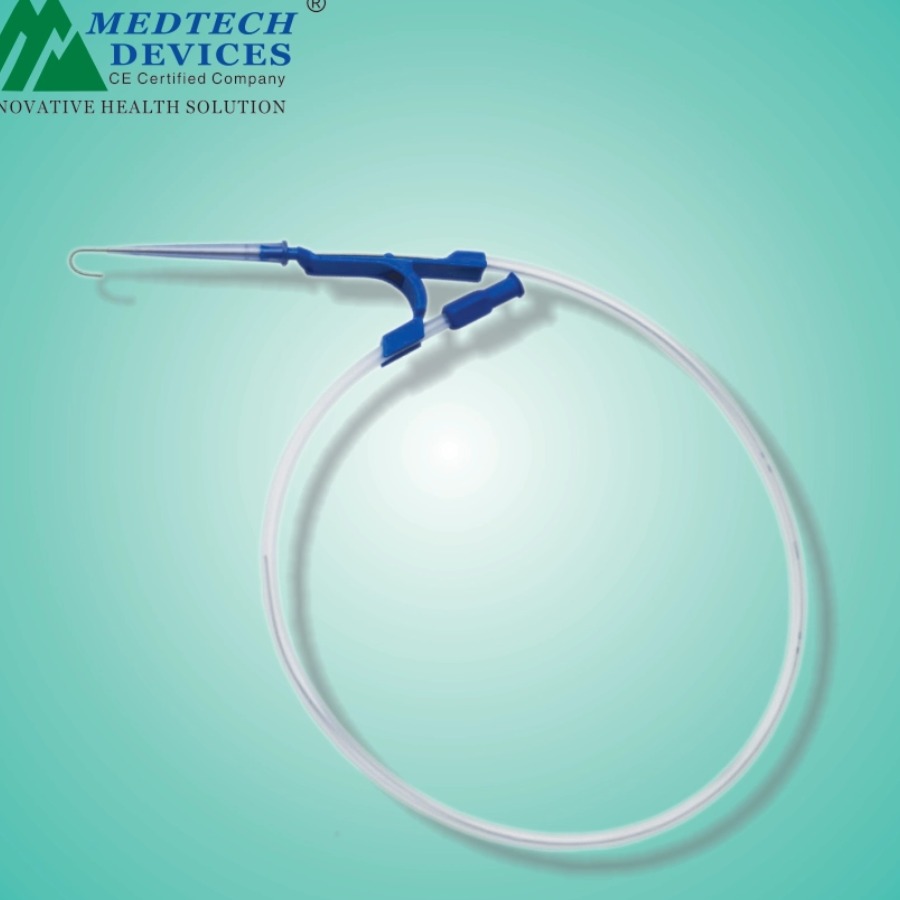Medtech Devices Pvt. Ltd. Catheter is a thin, flexible tube that is inserted into a body cavity, blood vessel, or duct to perform various medical procedures. Catheters are used for a wide range of purposes, including draining fluids, delivering medications, measuring pressures, and visualizing or treating specific areas within the body. Here are some common types of catheters and their uses: 1. Foley Catheter: This is a urinary catheter designed for inserting into the bladder through the urethra. It is used to drain urine from the bladder, often in cases of urinary retention or during surgical procedures. 2. Central Venous Catheter (CVC): These catheters are placed into large veins, typically in the neck, chest, or groin. They are used to administer medications, fluids, or nutrients directly into the bloodstream, as well as for monitoring central venous pressure. 3. Peripheral Intravenous Catheter (IV): These short catheters are inserted into a peripheral vein, often in the arm or hand, for the administration of medications, fluids, or blood products. 4. Pulmonary Artery Catheter (Swan-Ganz catheter): This specialized catheter is inserted into the pulmonary artery to measure cardiac output, pulmonary artery pressure, and other hemodynamic parameters. 5. Nasogastric (NG) or Orogastric Tube: These tubes are not technically catheters but are used for similar purposes. They are inserted through the nose (NG) or mouth (orogastric) into the stomach to remove stomach contents, deliver feedings, or administer medications. 6. Gastrostomy Tube (G-tube) or Jejunostomy Tube (J-tube): These are surgically placed tubes that provide a direct route for feeding and medication delivery into the stomach (G-tube) or small intestine (J-tube) for patients who cannot eat or swallow normally. 7. Cardiac Catheter: This catheter is used in cardiac catheterization procedures to diagnose and treat heart conditions. It is inserted into the blood vessels that lead to the heart. 8. Ureteral Catheter: These are used to access the ureters, the tubes that connect the kidneys to the bladder, often for the purpose of draining urine or delivering contrast dye during medical imaging. 9. Angiographic Catheter: Used in angiography, these catheters are designed to access blood vessels for diagnostic imaging, intervention, or procedures like stent placement or embolization. 10. Hemodialysis Catheter: For patients with kidney failure, hemodialysis catheters provide access to blood vessels for the removal and return of blood during hemodialysis treatment.
Chat with us on WhatsApp
×
This is your website preview.
Currently it only shows your basic business info. Start adding relevant business details such as description, images and products or services to gain your customers attention by using Boost 360 android app / iOS App / web portal.

2024-09-04T05:22:50
Medtech Devices Pvt. Ltd. Catheter is a thin, flexible tube that is inserted into a body cavity, blood vessel, or duct to perform various medical procedures. Catheters are used for a wide range of purposes, including draining fluids, delivering medications, measuring pressures, and visualizing or treating specific areas within the body. Here are some common types of catheters and their uses: 1. Foley Catheter: This is a urinary catheter designed for inserting into the bladder through the urethra. It is used to drain urine from the bladder, often in cases of urinary retention or during surgical procedures. 2. Central Venous Catheter (CVC): These catheters are placed into large veins, typically in the neck, chest, or groin. They are used to administer medications, fluids, or nutrients directly into the bloodstream, as well as for monitoring central venous pressure. 3. Peripheral Intravenous Catheter (IV): These short catheters are inserted into a peripheral vein, often in the arm or hand, for the administration of medications, fluids, or blood products. 4. Pulmonary Artery Catheter (Swan-Ganz catheter): This specialized catheter is inserted into the pulmonary artery to measure cardiac output, pulmonary artery pressure, and other hemodynamic parameters. 5. Nasogastric (NG) or Orogastric Tube: These tubes are not technically catheters but are used for similar purposes. They are inserted through the nose (NG) or mouth (orogastric) into the stomach to remove stomach contents, deliver feedings, or administer medications. 6. Gastrostomy Tube (G-tube) or Jejunostomy Tube (J-tube): These are surgically placed tubes that provide a direct route for feeding and medication delivery into the stomach (G-tube) or small intestine (J-tube) for patients who cannot eat or swallow normally. 7. Cardiac Catheter: This catheter is used in cardiac catheterization procedures to diagnose and treat heart conditions. It is inserted into the blood vessels that lead to the heart. 8. Ureteral Catheter: These are used to access the ureters, the tubes that connect the kidneys to the bladder, often for the purpose of draining urine or delivering contrast dye during medical imaging. 9. Angiographic Catheter: Used in angiography, these catheters are designed to access blood vessels for diagnostic imaging, intervention, or procedures like stent placement or embolization. 10. Hemodialysis Catheter: For patients with kidney failure, hemodialysis catheters provide access to blood vessels for the removal and return of blood during hemodialysis treatment.
2024-09-04T05:22:50
Keywords
- wide range
- body cavity
- large veins
- blood vessel
- contrast dye
- direct route
- common types
- blood products
- kidney failure
- specific areas
- cardiac output
- short catheters
- Orogastric Tube
- stent placement
- small intestine
- medical imaging
- peripheral vein
- stomach contents
- heart conditions
- similar purposes
- urinary catheter
- Jejunostomy Tube
- Gastrostomy Tube
- urinary retention
- Ureteral Catheter
- 1. Foley Catheter
- diagnostic imaging
- Swan-Ganz catheter
- medication delivery
- surgical procedures
- thin, flexible tube
- Medtech Devices Pvt
- specialized catheter
- Hemodialysis Catheter
- Angiographic Catheter
- hemodialysis treatment
- central venous pressure
- Pulmonary Artery Catheter
- pulmonary artery pressure
- various medical procedures
- 2. Central Venous Catheter
- other hemodynamic parameters
- Peripheral Intravenous Catheter
- cardiac catheterization procedures

Submit Your Enquiry